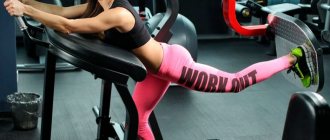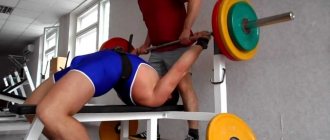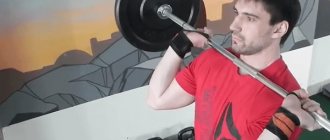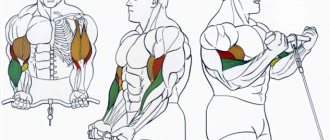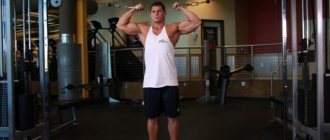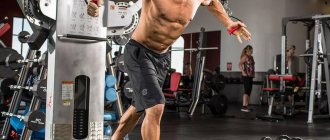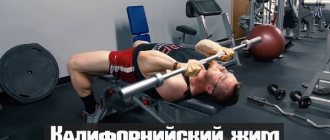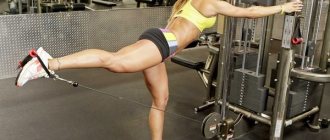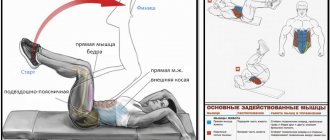Standing crossover crunches
Standing crossover crunches are an exercise that can effectively pump up your abs. Crunches in a block machine can mainly develop the upper abs. The specificity of this exercise is that the abdominal muscle feels freer compared to other exercises, thanks to this the exercise can be performed by beginners and receive a fairly high load. From my own experience, I will say that the vast majority of girls and men who have learned about standing crossover crunches do it incorrectly. The exercise itself is quite simple, but for some reason almost everyone in the gym makes mistakes when trying to pump up their abs with it.
Initial position
Attach a rope to the top block. Holding the rope with both hands, stand with your back to the block in a crossover, placing your hands on the sides of your neck. Pull your stomach in, bend your knees slightly.
Technique for performing crossover crunches while standing
As you exhale, twist your body forward until your elbows touch your legs. It is advisable to hold for 1 second, after the effort, smoothly unbend using your abdominal muscles.
Be sure to try for yourself to perform the crossover exercise while standing with a short amplitude and twisting until your elbows touch your legs.
Adviсe
- Please note that you need to twist, that is, the distance from the middle of the abdomen to the shoulders should be reduced.
- Take a weight with which you can perform the exercise at least 12 times per set.
- Be sure to smoothly straighten your back using your abdominal muscles.
- Try to work at a short amplitude without leaning forward.
- On the contrary, you can lean forward and in the starting position stretch your abdominal muscles as much as possible while leaning back.
- If you have learned how to do it with a rope, then try this exercise with a straight handle.
Errors
- Direct body tilts forward instead of twisting.
- Pressing your chin to your chest.
- Protruding the pelvis, using it as a counterweight.
Ezon Source: strong-life.ru
Crunches on the upper block. We study all the subtleties and secrets
Hello! Wednesday is the time for technical notes on the ABC of Bodybuilding project. And today we will talk about crunches on the upper block.
After reading, you will learn all about the benefits, muscle atlas and technique of performing the exercise, we will also find out the degree of its effectiveness and usefulness of inclusion in your training program.
So, take your seats, we're starting.
Crunches on the upper block. What, why and why?
The very first thing a beginner rushes to do in the gym is pump up his abs. I don’t know where this came from, most likely, this is the most famous (from physics lessons) and understandable exercise. Guys often get stuck on the Roman chair, and ladies often get stuck on the hyperextension machine (side position for removing the “ears”). In general, press training for most workers is limited to 2-3 exercises , often pumping the same section of the abdominal muscles . On the project, we are trying in every possible way to instill in athletes a broader view of their training process, so that they use a variety of exercises and use muscle units that previously did not receive (or received less) load. Next, we will just talk about a relatively rare press exercise, whose name is twisting on the upper block.
Note:
For better assimilation of the material, all further narration will be divided into subchapters.
Muscle atlas
The exercise is an isolating exercise, i.e. the main load goes to one specific muscle with the pull type of force.
The muscle ensemble includes the following units:
- targeted – rectus abdominis muscle;
- synergists – oblique abdominal muscles;
- stabilizers - iliopsoas, tensor fascia lata, rectus femoris, sartorius, latissimus dorsi, teres major, posterior deltoid, long head of triceps, rhomboid, lower trapezius, pectoralis major sternal/clavicular head, pectoralis minor, serratus anterior.
A complete muscle atlas looks like this.
Advantages
By performing a crunch exercise on an overhead pulley, you can expect to receive the following benefits:
- core muscle development;
- increasing the strength of the rectus abdominis muscles;
- visual reduction of the waist;
- improved posture;
- strengthening the lower back and reducing injuries;
- for back problems, it can be performed as a safe alternative to straight crunches while lying on the floor.
Execution technique
The exercise belongs to the “easy” class, but is not without its own characteristics. The step-by-step execution technique is as follows.
Step #0.
Go to the upper block of the crossover, install the rope handle and set the desired weight. Get down on your knees, taking the rope with a grip behind your head (your hands are at your neck and hold it). Hold yourself in a position as if you were about to perform a hyperextension. This is your starting position.
Step #1.
Inhale and as you exhale, keeping your hips still, bend at the waist as far as you can, as if you were doing a regular crunch. The elbows should move towards the middle of the thighs. At the bottom point, hold the peak contraction for 1 - 2 seconds. Slowly and in a controlled manner, while inhaling, return to the IP position. Repeat the specified number of times.
In the picture version, all this disgrace looks like this:
In motion (variant with a single handle) like this:
Variations
In addition to the classic version of crunches on the upper block, there are several variations of the exercise, in particular:
- standing at the top block with a rope handle;
- sitting on a bench with a single handle;
- cross twists at the top block with a single handle;
- with a straight handle and a reverse grip.
Secrets and subtleties
To get the most out of the exercise, follow these guidelines:
- work to move the weight of the weight should be carried out by contracting the abdominal muscles, in particular the rectus abdominis;
- keep your hips stationary throughout the movement;
- maintain tension in your abdominal muscles throughout the entire movement, without fully extending your back at the top point;
- perform extension much slower than contraction;
- at the lowest point, hold for 1 - 2 counts, additionally squeezing your abdominal muscles;
- work through a full range of motion;
- try to lower/twist as low as possible;
- select the optimal weight of the burden - it should not be too light or heavy;
- change the handle to a single handle and perform cross crunches if you want to load the obliques;
- use the exercise as an alternative to classic crunches for back problems;
- breathing technique: inhale - while straightening up, exhale - with effort, twisting down;
- numerical training parameters: number of approaches 3-5 , repetitions from 15-20.
We're done with the theoretical side, now let's look at some practical points.
Crunches - an effective abdominal exercise?
The EMG method – the electrical activity of muscles when performing various variations of press exercises – will help us understand the issue. So, research data from the Journal of Strength and Conditioning Research says the following about the activity of the rectus abdominis muscle in exercises:
- classic crunches lying on your back - 100%;
- raising the arms in a lock upward from a supine position – 119%;
- rolling a roller in a kneeling position – 145%;
- twisting on the upper block – 149%.
Data suggests that the exercise is quite effective for the rectus abdominis muscles, and coupled with the absence of negative stress on the spine/lower back (as with standard crunches on the floor), it is simply an excellent option.
Actually, that was all I would like to talk about, let’s summarize.
Afterword
Twisting on the upper block - this is exactly what we examined today, thereby adding to the arsenal of our press exercises. I am sure that now your press workouts will no longer be so bland :).
We read to the end and head into the hall for new sensations. Good luck!
PS. How many abdominal exercises do you use in your training, which ones?
P.P.S. Did the project help? Then leave a link to it in your social network status - plus 100 points for karma is guaranteed :).
With respect and gratitude, Dmitry Protasov.
If you liked the material, support us! Was it useful? Tell your friends:
Published in the section for the press technique
Take a course towards building a beautiful body! You can skip reading the entry and . Posting links is prohibited. Source: ferrum-body.ru
This is interesting: Vacuum exercise: explained in detail
Ab crunches on the upper block
A classic way to strengthen your abdominal muscles is to regularly perform crunches. One variation of this exercise is crunches on the top block of a cable machine. They allow you to work out your muscles as effectively as possible and remove unnecessary stress from the lumbar region.
Muscle work
When performing crunches on a block, absolutely all abdominal muscles work in a complex manner. This is the main advantage of this exercise.
Abdominal muscles working during the exercise.
More specifically, the movement involves:
- rectus abdominis muscle;
- oblique muscles (external and internal);
- transverse muscles (located under the internal obliques).
The undoubted advantage of crunches on a block is that their implementation does not create a load on the lower back. The exercise is quite comfortable and suitable for those people who have suffered injuries to the lower back and spine.
Of course, an important condition for the safety and effectiveness of the exercise is compliance with the movement technique. We will talk about it further.
Execution technique
Crunches on a block are performed on a cable machine. If you have been visiting the gym for a long time, you will be familiar with the exercise machine with the upper block from training the muscles of the back and arms.
First you need to set up the simulator and take the starting position:
- Attach a rope handle to the cable. Of course, you can perform exercises with a straight handle, but it is not as convenient and effective.
- Set up a small weight (too much weight will pull you up and prevent you from following the technique).
- Stand facing the machine and grab the handle by the ends so that both palms are facing inward. If you do decide to use a straight handle, use an overhand grip.
- Step back 1 step. Don't go too far. The maximum allowable distance is 1.5 m. Pull the handle towards you, bending your elbows, and carefully lower yourself to your knees.
- Pull the handle towards your head and round your body. The back should not straighten and the abs relax throughout the entire movement.
Performance:
- As you exhale, twist your body forward, lowering your head almost to the floor. Make sure that your back is rounded and not straightened, and that your torso does not sway to the sides. Contract your abdominal muscles as much as possible and pull your ribs inward.
- As you inhale, return to the starting position.
Repeat 20-25 times without stopping and take a short break. Do 1-2 more approaches.
Recommendations
The main mistake that beginners make when performing cable crunches is that they confuse this exercise with bending. Bending practically does not affect the abdominal muscles, transferring the main tension to other muscles. This makes crunches useless.
- When you do crunches, be sure to round your back from your lower back to your shoulders. At the same time, avoid creating a arch in the lower back. If you do the exercise with a straight back, the entire load from the press will be transferred to the back muscles.
- Do not pause too long or linger at any point in the amplitude. One repetition should follow another until the very end of the exercise. Rest is only necessary between sets.
- At the lowest point of the amplitude, the elbows should approach the knees, but you should not pull the weight down with your hands. The arms are simply a “coupling” between you and the machine; only the abdominal muscles make the effort. Many people try to bend down too low, literally touching their forehead to the floor. In fact, excessive bending not only does not make the exercise more effective, but, on the contrary, does not allow the muscles to work correctly.
- Try to keep your abdominal tension throughout the entire exercise.
- Keep your torso in one position. Rocking your body will result in some of the load going to your hips.
- Don't use heavy weights. Blocks that are too heavy can cause strain in your arm muscles, injure your elbow joints, and simply pull you up, preventing you from completing the exercise fully. To prevent this, choose the optimal weight.
Like other abdominal exercises, cable crunches should be performed at the end of your workout. The session should end with stretching.
Twisting on the upper block effectively affects the superficial and deep abdominal muscles. Regularly performing this exercise will allow you to achieve the desired six-pack, reduce your waist and give your stomach an ideal shape. It is perfect for both beginners and advanced athletes.
Source: FitNavigator.ru
The best exercises on block machines
Performing exercises on a block machine allows you to diversify your training program and improve progress in building muscle volume.
The peculiarity of such classes is that they are radically different from training with free weights. The blocks in the simulator can be pulled back and forth, to the sides, down and up. Free weights do not provide such flexibility, and muscles do not receive such comprehensive development. The muscles are worked out completely differently when the athlete trains on a block machine.
Lifting the barbell for biceps and performing crossover curls while standing have some differences in the technique of movement, and, consequently, in the impact on the muscles. This also applies to bent over arms, which are done in the simulator, which differs from the usual exercise with dumbbells, since the upper pectoral muscles work somewhat differently.
The variability of positions that block exercise machines provide is the main and main advantage of this sports equipment. Block exercises allow you to stimulate muscle growth. Athletes who previously worked only with free weights achieve especially high results.
Crunches on the upper block for the abs (exercise “Prayer”)
The traditional method of working out the abdominal muscles is various types of crunches. One of the variations of this exercise includes crunches on the upper block or the “prayer” exercise. This exercise allows you to most effectively pump up your abdominal muscles, as well as avoid unnecessary stress on the lumbar region.
Crunching on the upper block is one of the optimal exercises for building strength and definition of the abdominal muscles. Unlike classic crunches while lying on the floor, when practicing on a block, you can achieve a maximum range of motion to contract the abdominal muscles. This exercise is very popular among professional bodybuilders.
Benefits of the exercise “prayer” on the upper block:
- increase in the strength qualities of the abdominal muscles;
- toned stomach and abdominal tone;
- training of the entire core muscle group (stabilizer muscles);
- can be performed in case of previous injuries or problems with the spine.
Muscle load
When performing crunches on a block, absolutely all abdominal muscles work in a complex manner. This is the main advantage of this exercise.
The key advantage of this exercise is that it uses the entire array of abdominal muscles.
Crunches on the upper block include:
- rectus abdominis muscle;
- external and internal oblique abdominal muscles;
- transverse abdominal muscles.
The obvious advantage of crunches on the upper block is that it allows you to remove unnecessary unnecessary stress on the lumbar region.
For maximum benefit, efficiency, and also to reduce the risk of injury during training, it is necessary to strictly adhere to the technique of performing the movement, which will be discussed below.
Technique for performing crunches on a block
The exercise is performed using a simulator with an upper (vertical) block. As a rule, this simulator is used to perform exercises to work the muscles of the back or arms.
First of all, you need to adjust the upper block and take the starting position:
- Attach a rope handle for traction to the cable of the upper block. Of course, in the absence of a rope handle, you can use a straight or V-shaped handle, but they will be less convenient for twisting.
- Place moderate weights on the machine, which will allow you to perform the exercise with the correct technique.
- Approach the block with your face and grab the handle of the machine with a pronated (straight) grip. However, when using a straight handle, it is more convenient to hold it with a reverse grip.
- Move 1-1.5 meters back, but no further. Slowly lower yourself to your knees, overcoming the tension of the weight of the weight, bend your arms at the elbows.
- Bend your torso forward, slightly rounding your back. Pull the handle of the exercise machine towards your forehead. Keep your pelvis still, your back slightly rounded, and your abdominal muscles relaxed throughout the entire approach.
- As you exhale, gently twist your torso forward, lowering your head almost to the floor. The elbows should touch the knees. Round your upper body as much as possible, feeling the contraction of your abdominal muscles.
- At the lowest point of the amplitude, hold your position for 1-2 seconds.
- As you inhale, slowly return to the starting position. Do not straighten your back completely.
Do 3-4 sets of 12-20 reps. By adjusting the degree of load, you can shift the emphasis to the abdominal muscles.
Common Mistakes
The main mistake made by novice athletes when performing the “prayer” exercise on the upper block is simply bending the torso instead. Bending mainly loads the back muscles, while the abdominal muscles practically do not work.
- During the exercise, you should try to round the upper back, bringing it towards the pelvis. At the same time, do not allow the back to arch, especially in the lumbar region. If you do the exercise with a straight back, the entire load from the press will be transferred to the back muscles.
- Do not try to pull the weight with your hands; they only perform the function of holding the handle of the exercise machine in a fixed position in the area of your forehead. Otherwise, instead of the abdominal muscles, the exercise will include the arm muscles (triceps) and the latissimus dorsi muscles. Therefore, keep your shoulder girdle and arms still and feel the contraction of your abdominal muscles, which will allow you to achieve effective results.
- Do not bend too low to the floor, touching its surface with your forehead. Inclining too much will not necessarily lead to increased efficiency; the main goal is to shift the load to the target muscles, namely the abdominal muscles.
- Maintain tension in your abdominal muscles throughout the movement.
- Do not jerk downwards. Leave the body within the given trajectory of movement; swaying the body from side to side will lead to a violation of the correct technique.
- Do not use excessive weights on the machine. Excessively heavy weights can lead to an increased risk of injuries and sprains. Additionally, too much weight will pull you up and prevent you from doing the exercise correctly.
Like other abdominal exercises, crunches ("prayer") are recommended to be performed at the end of your workout.
For the most dramatic results, the best ab workout option is to combine this exercise with other abdominal exercises, such as traditional crunches or hanging leg raises.
Crunches on the upper block can be performed by both beginners and more experienced athletes. Systematic implementation of this exercise can put a targeted load on the abdominal muscles, which will allow you to achieve a toned stomach, reduce your waist and improve your relief.
Video: Twisting on the upper block on the press:
Share: Source: power-body.ru
This is interesting: Power press: bridge, technique, notes, practical recommendations and diagram of performing power press with a bridge
Crunches on blocks
The best isolation exercise for building powerful abdominal muscles that you should definitely include in your program. Execution technique.
The best abdominal exercise
The most important criteria for choosing the most effective abdominal exercise is both the involvement of the maximum number of fibers of the abdominal muscles, and the exclusion of secondary muscles from the work - primarily the muscles of the neck, back and front of the thighs.
Incorrect technique for performing hanging leg raises will shift a significant amount of load from the abdominal muscles to the muscles of the lower back and legs, and the inability to feel your abs in classic crunches activates the neck muscles, provoking the appearance of chronic pain.
Which abdominal exercise is better - crunches or hanging leg raises? How to pump up your abs effectively - the results of a scientific study.
Avoid challenging exercises
One of the first rules of abdominal training is to be able to feel the abdominal muscles and maintain them in a tense state while performing exercises. At the same time, technically complex exercises and too much additional weight significantly complicate the task.
Trying to start training weak abdominal muscles with the aforementioned hanging leg raises or roller crunches is doomed to failure. Untrained abdominal muscles will not be physically ready for such loads, forcing the body to use secondary muscles.
Crunches on the upper blocks
Performing crunches on the upper blocks allows you to both learn to feel your abs in work and limit the involvement of secondary muscles. It is especially important to remove unnecessary stress from the cervical region - a typical cause of pain and crunches in the neck among novice athletes.
An additional advantage will be that variations of crunches on blocks can include elements of the “Vacuum in the Abdomen” exercise - one of the few that trains the internal transverse abdominal muscles and creates not just strong, but toned and elastic abs.
Ab crunches on blocks: correct technique
The key parameter of cable crunches is the maximum range of motion. You should not be hampered by a too short piece of rope or a pulley weight limiter. The weight in the exercise should be moderate—you should never lift yourself off the floor.
1. Grasp the rope, step back a few steps and kneel down. Bend your elbows at a right angle. Lean forward, arching your back slightly. Shift your body weight onto your knees and toes, as if hanging from your arms (but without straining them). Feel the tension in your abs.
2. As you exhale, using your abdominal muscles, slowly twist until your elbows touch the floor or knees, constantly feeling the work of your abs. At the lowest point, the back should be slightly rounded. After a short pause while inhaling, slowly return to the starting position.
Complicated variation
To engage the oblique abdominal muscles, do not bend vertically downwards, but turn to the right or left side alternately. Point your right elbow towards your left knee, and vice versa. In this case, your free hand can be held either behind your back or on your knee.
Common mistakes
It is important to ensure that when performing crunches on blocks, the elbows do not extend and the position of the shoulders does not change, otherwise the load will fall on the arms and latissimus dorsi muscles, turning the exercise into something like a pullover. The movement should be carried out precisely by the abdominal muscles.
The pelvis should remain motionless during movement. The movement in the exercise starts from the lower back, as with a regular twist. If you begin to shift your pelvis and move it forward, the bulk of the work will shift from the abs to the hip flexors.
How many repetitions should I do?
To increase abdominal muscle strength and achieve massive abs, perform 3 sets of 6-10 repetitions. To work on the relief of your abdominal muscles, perform 3-4 sets of crunches on blocks with a high number of repetitions (from 12 to 25) and a lower working weight.
The exercise can be performed in every workout; it is important to ensure that its analogues (for example, reverse crunches) are not included in the program. A good addition to crunches on the upper blocks would be a plank or the aforementioned vacuum in the abdomen.
***
Crunches are one of the few isolation exercises for the abdominal muscles. A simple technique will allow even beginners to perform this exercise correctly, which guarantees quick results in the form of creating a powerful stomach and pumped up abs.
internal abdominal muscles, abdominal muscles, crunches, block exercises, abdominal exercises
Source: fitseven.ru
Typical beginner mistakes
Many abdominal exercises have their own technical nuances that you need to master in order to get the most out of them. Let's look at the most common mistakes, myths and misconceptions:
- You should not train your abs more than 1-2 times a week. Crunches are a fairly easy exercise, but even after it the body needs time to recover.
- By performing a large number of repetitions, you will not burn excess fat deposits on your stomach and get the coveted “cubes”. The optimal repetition range for crunches is 12-20; in combination with a diet tailored to your goals, this approach will give maximum results.
- Do not use too heavy a weight. If you do crunches with a disc or dumbbell, do not chase the weights, it is better to focus on mental concentration and contract the abdominal muscles more isolated, but involving no assistant muscles in the work.
Recipes for healthy eating
Hungarian beef goulash
- 5.9 g Protein
- 3.5 g Fat
- 4.6 g Carbohydrates
- 72.2 kcal
70-100 min.
- #wine
- #second course
- #beef
- #goulash
- #dietary
- #low calorie
- #dinner
- #roasting
- #olive oil
- #onion
- #rosemary
- #celery
- #thyme
- #dinner
Other recipes
How to properly perform crunches on the upper block to work the abdominal muscles?
To work out the abdominal muscle groups, a large number of different exercises are used, intended both for doing at home and for the walls of the gym. The second category includes crunches on the upper block using a simulator. The exercise is quite difficult to perform and effective for obtaining sculpted abdominal shapes.
Benefits of Exercise
This exercise, which also has the additional name “prayer,” has a number of advantages:
- during the training process, the core muscles are worked out (including the muscles of the abdomen, buttocks, back of the thigh, etc.);
- the characteristics of the strength capabilities of the direct muscle category of the press increase;
- the waist visually decreases in size;
- in addition to affecting the abdominal area, the back is strengthened and posture is improved;
- for back injuries and problems with the spinal column, it is performed as an alternative to straight twisting exercises performed on a hard surface;
- excess stress on the lower back is eliminated.
Muscle groups trained
When training with this exercise, all groups in the abdominal area are involved, which makes their development more effective. The following muscle categories are involved in the work:
- rectus abdominis muscles;
- internal oblique muscles;
- external oblique muscles;
- transverse abdominal region.
Technique for performing crunches on the upper block
In order to receive only the benefits of training, avoiding injury and other negative consequences from visiting the gym, you must strictly follow the rules for performing the exercises.
For the exercise in question, you will need a simulator with a vertical (upper) block, used to work the muscle groups of the back, shoulders and arms. Before starting work, you need to carry out the procedure for adjusting the simulator and take the initial (starting) position.
The technique of performing the exercise consists of the following steps:
- First of all, it is recommended to choose block weights. For beginners, it is not advisable to set a large weight, since due to the lack of the required physical training, you can get injured. It is best to consult a trainer.
- For a more comfortable and effective lesson, you need to install a rope handle. If you do not have the required handle, you can use a standard straight or V-shaped one, which are much less convenient for performing twists.
- Get down on your knees. Your arms should be bent at the elbows.
- To take the initial position of the body, you must first approach the machine with your face, then grab the rope with a direct grip. If a straight handle is used, a reverse grip is recommended.
- Next, it is advisable to tilt the body forward, slightly rounding the back, pulling the handle as close to the forehead as possible.
- The exercise begins with twisting the body forward. The head should be lowered as much as possible, not reaching a few cm to the floor. The elbow joints should touch the knees, the torso should be as rounded as possible. The abdominal press contracts. During this period you need to exhale.
- When you reach the position indicated in the previous paragraph, you need to hold it for 2 seconds.
- When inhaling, you need to take the primary position of the body. You cannot straighten your back all the way.
- It is necessary to keep all muscles tense throughout the entire workout to avoid various injuries.
You can understand how this exercise is performed correctly by watching this training video:
For people who regularly exercise at a sports center, about 4 approaches are performed, including about 15-20 repetitions of the task. Varying degrees of load affect the definition of training emphasis, depending on which result is a priority.
Variations of the exercise
There are several options for how to perform crunches on the upper block.
First variation
While performing this exercise, you should be with your back to the machine and your feet resting on it. During training, a rope handle is used in full compliance with technical instructions. In addition to the simulator, you will also need a fitness mat so that during training there is no pain in the knee joints.
How to perform this version of twisting, see this video:
Second variation
A straight handle can also be used for crunches. When using it, you will need supports for the legs, which it is advisable to raise. It is not recommended to use this variation due to inconvenience during training.
Third variation
An inclined bench is taken as a support for the legs and installed close to the exercise machine. The V-shaped handle used is taken with a comfortable grip in a standing position. Next, you need to sit down on a bench, lowering your hands behind your head. The legs are usually shoulder-width apart. This variation acts as a load on the upper abdominal muscles.
Fourth variation
Crunches on the upper block can also be performed while standing. How to do it correctly, watch this video:
Common Mistakes
The most common errors are as follows:
- performing crunches using the back rather than the abdominals;
- establishing a large mass during the first training sessions;
- complete or partial failure to comply with technical recommendations;
- using only the arms to lift the weight;
- hitting the floor with your head: a stronger tilt does not increase the effectiveness of the workout, but can lead to a shift of the load from the abdominal cavity;
- insufficient tension of the torso during crunches.
To obtain the required result by twisting on the upper block, it is recommended to follow all technical recommendations for performing the exercise. Heavy loads are not recommended for beginners. Increasing weight on the machine should occur gradually to minimize the risk of injury.
Source: krasota-zdorove.com
How to perform abdominal crunches with body rotations?
Crunches with body rotations are an excellent exercise for working the rectus and oblique abdominal muscles. In bodybuilding, there are a large number of options for performing this exercise, but the most common of them are crunches while lying on the floor or a Roman bench.
Technique for performing crunches with body rotations
Main muscles worked: rectus abdominis and obliques.
Technique:
- Take a lying position on the floor or a Roman bench: in the first case, bend your knees and place them completely on your feet, and in the second, fix your legs under the support bolsters;
- Place your hands on the back of your head and lower yourself to the bottom of the exercise (if you are performing this exercise on the floor, then lower yourself to the floor; if you are using a Roman bench, then position your body parallel to the floor or slightly lower);
- Begin to twist, rising upward due to the isolated effort of the abdominal muscles, while turning the body first to the left, then to the right, placing your left hand behind your right leg, and your right hand behind your left leg;
- Maintain a low pace of the exercise, take a short pause at the top point of the amplitude;
- Perform 3 sets of 15 reps each.
Practical recommendations
- Do not use the force of inertia, but try to perform the exercise using isolated abdominal pressure;
- Do not bend your neck too much, a slight rotation of the body will be enough;
- Do not help yourself with your hands and do not try to touch your elbows to your legs;
- When performing the exercise on a Roman bench, use a short range of motion - do not lie completely on the bench, but keep your body parallel to the floor;
- When doing Roman crunches, keep your back rounded throughout the entire set.
Tips for Maximum Productivity
- Try to release as much air as possible while twisting.
This will help reduce intra-abdominal pressure and contract the abdominal muscles more strongly.
- Do not use cheating (fixed repetitions). When cheating, additional muscles are activated. Such as: back, hip flexors and spine. And almost the entire load begins to fall on them. As a result, the press practically does not work. And if this is so, then our efforts are zero.
- Do not swing while performing the exercise. When rocking the body, the emphasis will shift from the straight to the oblique abdominal muscles. Which will not allow us to work on this area 100%. And without the proper intensity in your work, you shouldn’t expect great results.
- Alternate exercises from the upper to the lower abs . You should not do only exercises aimed at the upper abs. Alternating will help you load the muscle from different angles. This will be a new stress for the body, to which it will immediately respond by compacting the loaded area.
- There is no need to do 100 or 200 repetitions of the exercises. This method doesn't work. I have yet to meet anyone who can perform high reps with proper form. Therefore, it is better to focus on quality rather than quantity.
